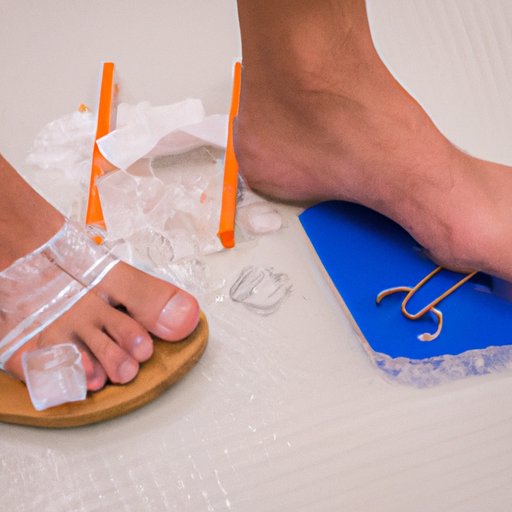
I. Introduction
Breaking a toe may seem like a minor injury, but it can cause significant pain and discomfort. In this article, we will explore the treatment options for a broken toe, including rest and ice, buddy taping, elevating the foot, painkillers, wearing comfortable shoes, using a walking boot, and physical therapy.
While some people may try to tough it out and go about their daily routine, proper treatment is crucial to avoid complications and promote healing.
II. Rest and Ice
Resting and icing the affected area is one of the most effective ways to reduce pain and swelling associated with a broken toe. Resting allows the toe to heal and prevents further injury, while ice helps to numb the area and reduce inflammation.
To apply ice, use a cold pack or a bag of frozen vegetables wrapped in a towel and place it on the toe for 20-30 minutes several times a day. It’s important not to apply ice directly to the skin, as this can cause frostbite.
As for rest, avoid any activities that put pressure on the toe, such as running or jumping. Instead, try to keep the foot elevated as much as possible.
III. Buddy Taping
Buddy taping involves attaching the broken toe to a neighboring toe to provide support and stability. This method is particularly useful for minor fractures that do not require a cast or splint. It helps to prevent the toe from moving and reduces discomfort when walking.
To tape, place a small piece of cushioning between the toes and then wrap athletic tape around both toes, keeping them firmly together. Ensure that the tape is not too tight, as this can cut off circulation.
It’s important to note that this method is not suitable for all kinds of foot injuries and may cause further damage if not done correctly. Seek medical attention to ensure that this method is the right choice for your situation.
IV. Elevate the Foot
Elevating the foot is an easy way to reduce swelling and pain. When elevated above the level of the heart, blood and fluid can drain from the affected area, which speeds up the healing process.
To elevate the foot, place a few pillows or a cushion under the foot while sitting or lying down. It’s recommended to elevate the foot for at least 15-20 minutes several times a day.
V. Take Painkillers
If the pain is severe, over-the-counter painkillers such as acetaminophen, ibuprofen, or naproxen can provide temporary relief. These medications help to reduce pain and inflammation, making it easier to manage discomfort while healing. In some cases, the doctor may prescribe something stronger.
It’s important to use these medications as directed and not to exceed the recommended dosage.
VI. Wear Comfortable Shoes
Choosing the right footwear is essential for managing pain and promoting healing. Wearing comfortable shoes with a wide toe box can help to prevent additional pressure on the toe, reducing discomfort while walking. Avoid wearing high heels, tight shoes or pointed-toe shoes.
Furthermore, orthopedic shoes or custom-fitted shoes can also support the broken toe and prevent further injury. Seek advice from a professional to choose the correct shoe that suits your needs.
VII. Use a Walking Boot
A walking boot is a medical device that can help immobilize the affected area and provide additional support. It’s useful for more severe fractures that require more significant comfort or support. A boot is not mandatory, but it’s helpful in the right cases.
The boot should be fitted by a medical professional and worn as directed. It’s important to avoid putting too much weight on the foot while wearing the boot to prevent further injury.
VIII. Physical Therapy
Physical therapy may be needed for more severe breaks. Physical therapy utilizes a range of motion exercises to help strengthen the muscles around the broken toe, allowing for quicker healing and daily functioning of the affected area. It’s also beneficial to help prevent stiffness and reduce pain.
It’s important to seek advice from a medical professional before starting physical therapy or other exercises to avoid further injury.
IX. Conclusion
Broken toes can be agonizing, and seeking treatment is crucial to ensure the best possible outcome. Resting the foot, ice treatment, and buddy taping are effective methods of reducing inflammation and swelling. A walking boot, painkillers, elevating the foot, wearing comfortable shoes, and physical therapy can also aid in recovery.
If you have a broken toe, it’s essential to seek medical attention to determine the best course of action and avoid any complications that may occur from inadequate treatment. It’s easy to neglect it with such seemingly minor injuries, but proper care can prevent future problems and allow you to heal quickly.




